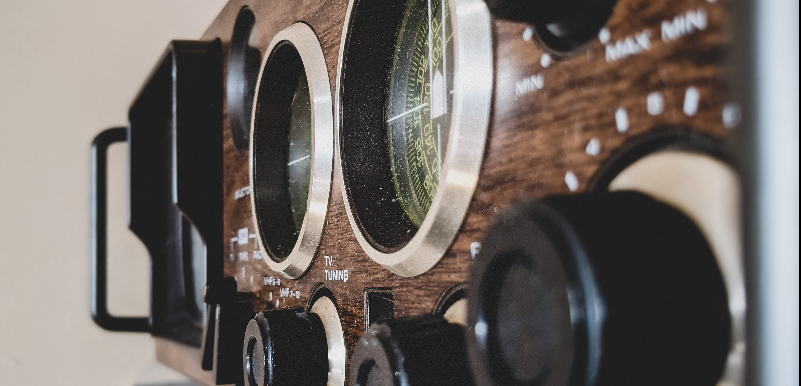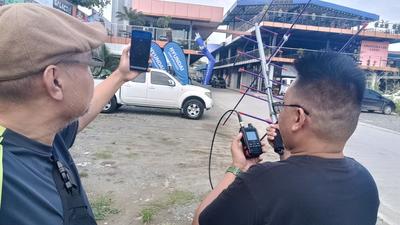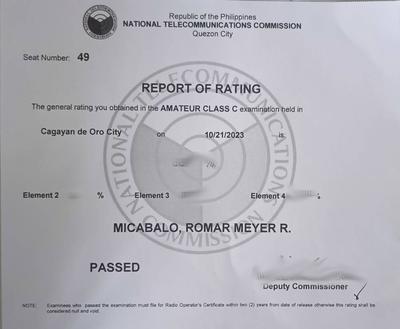
I have always been fascinated by wireless communications, most especially radio. My father was a police officer way back and he would bring home one or two handheld radios of various brands which caught my fancy. Usually, it's either a Motorola, a Kenwood, or an Icom. Everytime the handhelds emit audible scratches and squeals, I would always try to listen in, curious as to what the person at the otherside was talking about, what the code words were, what radio was used, and how to actually make the call. Fast forward some decades later, I was already working in the IT industry totally oblivious about radios while deeply immersed amongst computers and software. Then a co-worker took and passed his Technician's license exam. It got me curious, reigniting a long lost spark around radio and wireless communications.
CATALYST
Fresh out of the pandemic, Aryan (callsign 4G9KKZ) decided to take his Technician's license exam, passed it, and has been sharing with me his experience immersing himself in the local HAM world here in the Philippines. At first I was just listening intently on his adventures establishing contacts (aka QSO) at first with local HAM stations and then much later, foreign HAM stations to as far as Indonesia, Thailand, Okinawa, and even Guangdong in China via satellite repeaters with only a small handheld transceiver from Yaesu. He was also showing me images he downloaded from NOAA satellites as they pass near Philippine airspace. Each image and adventure Aryan was sharing with me has gradually reignited the spark and curiousity within me to try radio communications.
Earlier this year Aryan passed his General license exam (he's now 4I9KKZ) and has been relentlessly encouraging me to give it a crack. Spurned by his neat little victories with the HAM exams, I relented. This was sometime late July. Considering that the next and last scheduled exam for the year to be held in the city is on October 21, 2023, I still have around two or three months of focused studying and review to try and pass the Technician's exam.
PREPARATION
One pre-requisite to be able to take the amateur radio licensure exam is that all candidates must have undergone a seminar or training from an accredited amateur radio group. As fate would have it, the Radio Engineering Circle is holding a free training for the Fundamentals of Radio on August 12, 2023. It is a preparatory training for taking the NTC Class C Amateur Radio Examination which covers all the necessary topics including Element 2: Rules and Regulations, Element 3: Fundamentals of Electronics, and Electricity, and Element 4: Amateur Radio Practice.
Although the actual training was in person, Radio Engineering Circle made the training available simultaneously online to people like me who live far, but have enough bandwidth to join remotely. They also issued a training certificate which you will need to attach to your application form when you apply for the exams at the NTC to serve as proof that you have undergone training on amateur radio fundamentals.
To file for my application to take the exams, I paid a visit to the nearest office of the National Telecommunications Commission (NTC), presented a photocopy of a government issued ID, filled up the application form, attached the printed training certificate, and paid fifty (50) pesos as examination fee. The NTC staff then informed me of the date of the exam (October 21, 2023) but the final examination venue was to be finalized (which later turned out to be at the University of Science and Technology of Southern Philippines - USTP). I had to make sure to keep the receipt and present it to the proctor on examination day.
POINT OF NO RETURN
With the examination applied and paid for, all I need to do is prepare for the examinations a few months ahead. It was he last days of August 2023 and I have around two or three months to prepare.
Even if it has been decades since I was last in school, fortunately for me, a lot of the electronics and electrical fundamentals are still pretty much familiar territory. My work experience as a Computer Technician and Systems Administrator pretty much helped me retain a lot of the theoretical and practical know how around electronics and electricity. Regardless, I had to make sure that I was reviewing and studying the right things that were covered during the training, and are going to be expected to come out of the exam. Topics like Ohm's Law, Kirchoff's Law, schematic symbols, series and parallel circuits, were all fair game. The topics covered in the Fundamentals of Radio were a huge help in order for me to prepare. The months ahead were devoted so that I will be able to retain a lot of the study materials and to also understand their relevance in terms of radio operation. It was arduous, considering that I am no longer a springbuck, and add to that my gruelling regular work managing cloud infrastructure and supporting developers which are totally different from amateur radio exam preparations but equally stressful.

(Image above showing 4I9KKZ and 4G9LBZ tracking an amateur satellite repeater using an Arrow Yagi antenna and a Yaesu handheld transceiver.)
THE EXAM
D-Day, October 21 came and I went to the exam venue extra early. I wasn't cramming the night before. I was relaxed. I had months to prepare. I also had experience in my hands in terms of technical stuff. In a way, I was confident that I can do it. I was given the number Seat 49. I needed to make sure to take a picture of the roster posted at the door of the examination venue. The seat number corresponds to the exam item set that will be given to me, and it will also be the same seat number that I will need to present at the NTC when it's time to get the examination results and Report of Rating.
The examination itself was not entirely surprising. A lot of the items I studied, or variations thereof, came out of the exam. As long as the concepts were understood, I believed I can pass it. There were 25 items for Element 2, 25 items for Element 3, and 25 items for Element 4. I took my time with the exam, around a good hour and a half.
My buddy Aryan (4I9KKZ) was actually outside the examination venue talking to fellow licensed HAM operators when he nodded at me and asked how it went. I replied it was good, there were some items that were tricky but overall, I feel confident.
THE LONG WAIT OVER
As quick as the exam went, waiting for the examination results was long and riveting. Work kept me preoccupied but it hasn't stopped me from checking the NTC website for examination results when November came. It even came to a point that I was checking the NTC website twice a day in the last week of November!
Then it finally came. The examination results for our batch of examinees was released online on December 6, 2023. I'm finally on my way to becoming a licensed amateur radio operator.
Knowing the results are out, I visited the nearest office of the NTC and filed for an application for Radio Operator's Certificate (ROC). I am not going to be issued a license for the moment considering that I am not yet a fully recognized amateur radio station without a radio. When I finally have a working radio in my possession, that's the time I become an operator of an NTC-recognized amateur radio station, with an equivalent amateur radio license (the license). Until then, I will have an ROC as proof that I am an NTC-recognized amateur radio operator.

(The Report of Rating from the NTC showing that I passed the exam, with breakdown of percentages per element.)
To obtain my ROC, I needed to accomplish their Operator Certificate Application Form, included four (4) 1x1 ID photos, and a government issued ID (I showed them my National ID). I also informed the NTC staff of my exam seat number so they can verify my examination results. The NTC staff then came back with my Report of Rating. I was also advised of the fee totalling to 180 pesos which covers the Radio Operator's Certificate (90 pesos), application and filing fee (60 pesos), and documentary stamp tax (30 pesos). I was then presented with a logbook containing available callsign allocations and to choose an available one from the list.
After paying for the scheduled fees, the NTC staff, returned the payment receipt to me, and released my Radio Operator's Certificate with my assigned callsign.
I am now also known by the callsign 4G9LBZ (read: four golf nine lima bravo zulu). I can now identify myself across the airwaves with my callsign, can participate in amateur radio netcalls digitally, but will still be unable to transmit via RF (radio frequencies) until I have finally secured my own radio, and a Radio Station License.

(My Radio Operator's Certificate showing my assigned callsign.)
NEXT STEPS
In order for me to be able to purchase my own radio, I will need to obtain a Permit to Purchase from the NTC. And I did just that while I am still at their office when I obtained my ROC. I had to pay for the permit to purchase (50 pesos), filing fee (60 pesos), and documentary stamp tax (30), totalling to 140 pesos. I was then issued an official receipt, and a Permit to Purchase document stipulating the make, type, and model of the radio that I can purchase, the number of units I can purchase, and the frequency range and power output of the equipment that I am going to purchase. The Permit to Purchase document is also valid for 60 days from the date of issue in order to give the radio operator ample time to look for radio that will fit his requirement and use.
Obtaining a permit to purchase will ensure that the radio equipment will be properly, and legally, attached and bound to my radio station and the relevant radio equipment make and model stipulated under my radio station license. Without a permit to purchase, I will end up paying for a hefty penalty for each radio equipment that I will register under my amateur radio station. The NTC provides a window of opportunity for amateur radio operators with unregistered equipment to have their equipment registered through their annual amnesty program.
I actually settled for an affordable radio from Cignus, the Cignus UV-86. You would actually hear most amateur radio operators to be settling for a Baofeng UV-5r or some other Baofeng model. Some would even say hey went for a Yaesu, or Icom. But all that is largely dependent on the person's budget, and the type of amateur radio activities that the person will be engaging in moving forward. In my case, I am looking more into tracking amateur satellites (amsat), SSTV (slow scan TV), downloading NOAA image data, satellite telemetry, and some occasional contacts (aka QSOs) with other HAM operators where my equipment can reach.
I got my UV-86 registered and bound into my radio station license (RSL) with the requisite forms and fees that goes along with it. Whether the UV-86 is a good radio for a beginner is a whole other matter altogether. But suffice to say, embarking on a new journey as an amateur radio operator was not entirely succinct but it was an interesting start, and I can now look forward to being able to do more exciting things like homebrewing antennas, establishing contacts with tricky satellites operating on different frequency bands, and QSOs with fellow HAMs that are farther than I can previously contact with.
There are so many things to write about, like APRS, DVSwitch, EchoLink, digital modes, DMR, and others, but it's a start. I think I'm on an exciting path.
73 and 59 always.
4G9LBZ